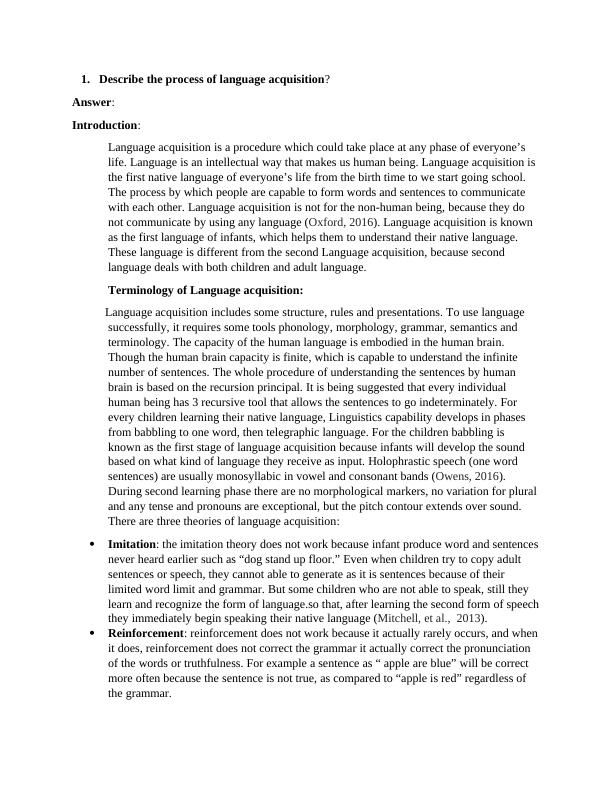Language Acquisition Assignment
Added on 2020-05-08
9 Pages3016 Words65 Views
1.Describe the process of language acquisition?Answer:Introduction: Language acquisition is a procedure which could take place at any phase of everyone’s life. Language is an intellectual way that makes us human being. Language acquisition is the first native language of everyone’s life from the birth time to we start going school. The process by which people are capable to form words and sentences to communicate with each other. Language acquisition is not for the non-human being, because they do not communicate by using any language (Oxford, 2016). Language acquisition is known as the first language of infants, which helps them to understand their native language. These language is different from the second Language acquisition, because second language deals with both children and adult language. Terminology of Language acquisition: Language acquisition includes some structure, rules and presentations. To use language successfully, it requires some tools phonology, morphology, grammar, semantics and terminology. The capacity of the human language is embodied in the human brain. Though the human brain capacity is finite, which is capable to understand the infinite number of sentences. The whole procedure of understanding the sentences by human brain is based on the recursion principal. It is being suggested that every individual human being has 3 recursive tool that allows the sentences to go indeterminately. For every children learning their native language, Linguistics capability develops in phases from babbling to one word, then telegraphic language. For the children babbling is known as the first stage of language acquisition because infants will develop the sound based on what kind of language they receive as input. Holophrastic speech (one word sentences) are usually monosyllabic in vowel and consonant bands (Owens, 2016). During second learning phase there are no morphological markers, no variation for plural and any tense and pronouns are exceptional, but the pitch contour extends over sound. There are three theories of language acquisition:Imitation: the imitation theory does not work because infant produce word and sentencesnever heard earlier such as “dog stand up floor.” Even when children try to copy adult sentences or speech, they cannot able to generate as it is sentences because of their limited word limit and grammar. But some children who are not able to speak, still they learn and recognize the form of language.so that, after learning the second form of speechthey immediately begin speaking their native language (Mitchell, et al., 2013).Reinforcement: reinforcement does not work because it actually rarely occurs, and whenit does, reinforcement does not correct the grammar it actually correct the pronunciation of the words or truthfulness. For example a sentence as “ apple are blue” will be correct more often because the sentence is not true, as compared to “apple is red” regardless of the grammar.

Analogy: analogy cannot explain the theory of language acquisition. The term analogy includes sentence formation, sentence phrasing with the help of other sentences. For example if a child hears sentence,” I painted a green table,” he might can say, by using term analogy, “I painted a blue table.” Though if child hears correct sentence which is” I painted a green table,” child cannot say “ I saw a red table.” This time analogy theory will not work and also this not an English sentence (Barry, 2017).Conclusion:The Poverty of the stimulus tells that children are very curious to know the features of the grammar for which they get no info. Children are not able to form some sentences properly and these sentences are not understandable in human language.References:Barry, P., 2017.Beginning theory: An introduction to literary and cultural theory. Oxford University Press.Mitchell, R., Myles, F. and Marsden, E., 2013.Second language learning theories. Routledge.Owens Jr, R.E., 2016. Language Development: An Introduction| Edition: 9.Instructor.Oxford, R.L., 2016.Teaching and researching language learning strategies: Self-regulation in context. Taylor & Francis.2.What are the differences between animals and human beings that make language possible for human beings?Answer: Introduction:What thing differentiate humans from animals, the very first thing that would come in human mind is language. Language is a very important part of human’s life, it is hard to visualizing what humans life would be like without language. In fact language referred to it as a body part ofhumans. Language term is derived from the Latin word lingua, meaning of lingua is tongue. For existence in the human society, the very first condition for everyone is Verbal Communication. Meanwhile animal also communicate, they have their own languages, sign, and sounds to communicate with each other (Liu, et al., 2016).Human language VS Animal communication:

DifferencesHumanAnimalsDuality of modellingDifferent sounds called phonemes. These phonemes have no meanings. But human have many ways to communicate with each other via words or via sentences (Tester, 2014).But animals do not use the arbitrary sound for communicate with each other,they can send limited messages to their partners.Creativeness Human can invent new wordseasily.Animals need to send their messages by signs.

End of preview
Want to access all the pages? Upload your documents or become a member.
Related Documents
Assignment On Language Acquisitionlg...
|9
|2818
|380
Critical Period Hypothesis and Acquisition of Languagelg...
|6
|1545
|396
Language Acquisition of Childrenlg...
|11
|2861
|50
Theories of Language Acquisition and Attachment in Childhoodlg...
|8
|2284
|349
Language and Literacy Assignmentlg...
|7
|1530
|100
Language Development Assignmentlg...
|4
|1478
|979
